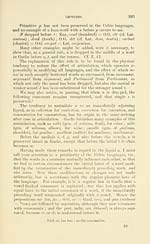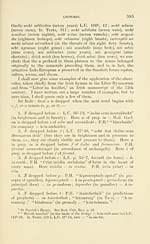Ossian Collection > Reliquiae Celticae > Volume 2
(608)
Download files
Complete book:
Individual page:
Thumbnail gallery: Grid view | List view

594 LECTURES.
Ill the same way the rules stated above as appHcable to n in
the middle of a ward apply to it likewise as an original termination.
In the latter case those rules may be briefly expressed as follows : —
1. When a word which originally terminated with n is followed
by a word beginning with s, f, or a tenuis (c, p, or t), the nasal is
dropped ; or, more briefly, ?i-auslaut is drojjped before s, f, and the
tenues.
2. When a word which originally terminated with n is followed
by a word beginning with a liquid (/, m, ?i, or r), the nasal is
assimilated to the liquid, with which it frequently coalesces.
3. When a word which originally terminated with n is followed
by a word beginning with a medial (b, d, or g), or with a vowel,
the nasal is preserved, but is transported or carried over to the
following word, and prefixed to its initial letter. Before b the n
becomes m.
These rules are regularly observed in Old and Middle Gaelic.
I shall here give a list of the forms which terminated originally
wfth n, and to which, therefore, the above rules are applicable : —
1. The article in the nom. sing, neuter, and in the ace. sing,
and gen. plur. of the three genders.
2. The fl stems in the same cases. Also, in the same cases^,
other neuter stems, which follow the analogy of the neuter a stems,
as tech (house), leth (half), viuir (sea).
3. Generally, the ace. sing, of all masc. and fem. nouns, and
the gen. plur. of all nouns.
1. The numeral da in tlie nom. dual neuter, and in the dat.
plur. of the three genders.
5. The poss. pronouns ar, am (our), far, /am (yours), and a,.
an (their).
6. The prepositions con (with), in (in), iar, iarn (after), and re,
ren (before).
7. The numerals i^echf (seven), ocht (eight), noi (nine), and
deich (ten).
8. The relative pronoun a, an (their).
9. The infixed pronouns a, da (him, eu7n) and s (her, eain ;
them, eos).
By comparing these forms with their related forms in other
languages, we ascertain that they terminated originally with ?i.
For example, when we compare secht with Skr. sajitan, Zend kaptaiiy
Lat. septeni and Goth, sibun ; ocht w'th Skr. ashtan, and Zend
astan ; iioi with Skr. navan, Zend navan, Lat. novem, and Goth.
iiiun ; and deich with Skr. da(^an, Zend dacan, Lat. decern, Goth.
taihun, and Old High. Germ, zehan, and when we find in Old
Ill the same way the rules stated above as appHcable to n in
the middle of a ward apply to it likewise as an original termination.
In the latter case those rules may be briefly expressed as follows : —
1. When a word which originally terminated with n is followed
by a word beginning with s, f, or a tenuis (c, p, or t), the nasal is
dropped ; or, more briefly, ?i-auslaut is drojjped before s, f, and the
tenues.
2. When a word which originally terminated with n is followed
by a word beginning with a liquid (/, m, ?i, or r), the nasal is
assimilated to the liquid, with which it frequently coalesces.
3. When a word which originally terminated with n is followed
by a word beginning with a medial (b, d, or g), or with a vowel,
the nasal is preserved, but is transported or carried over to the
following word, and prefixed to its initial letter. Before b the n
becomes m.
These rules are regularly observed in Old and Middle Gaelic.
I shall here give a list of the forms which terminated originally
wfth n, and to which, therefore, the above rules are applicable : —
1. The article in the nom. sing, neuter, and in the ace. sing,
and gen. plur. of the three genders.
2. The fl stems in the same cases. Also, in the same cases^,
other neuter stems, which follow the analogy of the neuter a stems,
as tech (house), leth (half), viuir (sea).
3. Generally, the ace. sing, of all masc. and fem. nouns, and
the gen. plur. of all nouns.
1. The numeral da in tlie nom. dual neuter, and in the dat.
plur. of the three genders.
5. The poss. pronouns ar, am (our), far, /am (yours), and a,.
an (their).
6. The prepositions con (with), in (in), iar, iarn (after), and re,
ren (before).
7. The numerals i^echf (seven), ocht (eight), noi (nine), and
deich (ten).
8. The relative pronoun a, an (their).
9. The infixed pronouns a, da (him, eu7n) and s (her, eain ;
them, eos).
By comparing these forms with their related forms in other
languages, we ascertain that they terminated originally with ?i.
For example, when we compare secht with Skr. sajitan, Zend kaptaiiy
Lat. septeni and Goth, sibun ; ocht w'th Skr. ashtan, and Zend
astan ; iioi with Skr. navan, Zend navan, Lat. novem, and Goth.
iiiun ; and deich with Skr. da(^an, Zend dacan, Lat. decern, Goth.
taihun, and Old High. Germ, zehan, and when we find in Old
Set display mode to: Large image | Transcription
Images and transcriptions on this page, including medium image downloads, may be used under the Creative Commons Attribution 4.0 International Licence unless otherwise stated. ![]()
| Early Gaelic Book Collections > Ossian Collection > Reliquiae Celticae > Volume 2 > (608) |
|---|
| Permanent URL | https://digital.nls.uk/81694082 |
|---|
| Description | Vol. II. |
|---|---|
| Shelfmark | Oss.288 |
| Attribution and copyright: |
|
| Description | Selected books from the Ossian Collection of 327 volumes, originally assembled by J. Norman Methven of Perth. Different editions and translations of James MacPherson's epic poem 'Ossian', some with a map of the 'Kingdom of Connor'. Also secondary material relating to Ossianic poetry and the Ossian controversy. |
|---|
| Description | Selected items from five 'Special and Named Printed Collections'. Includes books in Gaelic and other Celtic languages, works about the Gaels, their languages, literature, culture and history. |
|---|

